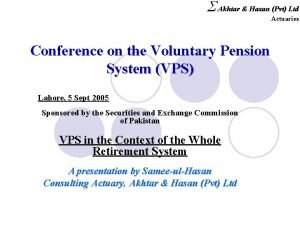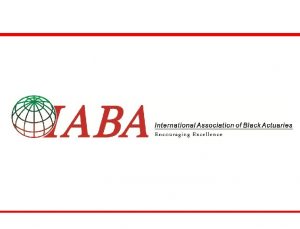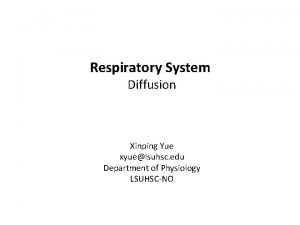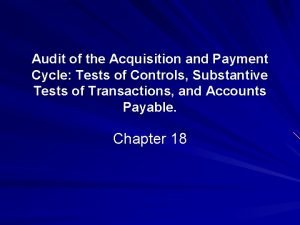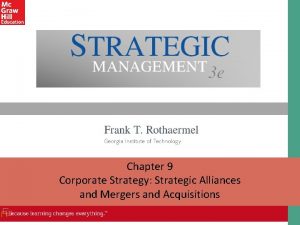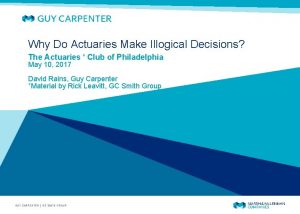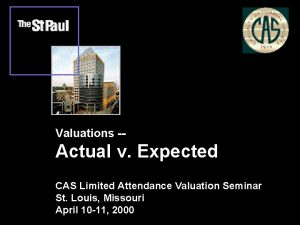Actuaries in Acquisitions CAS Limited Attendance Seminar on










- Slides: 10

Actuaries in Acquisitions CAS Limited Attendance Seminar on Valuation St. Louis, Missouri April 10 -11, 2000

Acquisition process Phase I: Internal Phase II: External Phase III: Legal Phase IV: Operational Identification Fit Analysis Value Merger Effects Iterative Due Diligence Negotiate & Close Integrate

Actuarial involvement in the process Actuaries could, perhaps should, be involved in every major step of the acquisition process. 4 Critical areas: Valuation m Due diligence m 4 Important areas: Merger consequences m Proactive identification m Deal structure m

Valuation 4 Sturgis lists five forms of valuation: m Market m Book m “Comparative” m “Dilution” m Economic 4 Miccolis defines economic value as: {Stat. Net Worth + Reserve Adjustments + Non-admitted assets + Special Liabilities - Excess of Book over Market of Bonds} + {NPV(Future Earnings) - Cost of Capital}

Valuation (continued) The valuation is the sum of : 4 The “true value” of the balance sheet (old business) 4 The “true value” of the current and future business on an “as is” basis Market Value 4 Marginal value to the buyer of intended use Economic Value 4 Are there other sources of value? m Option value m Intangibles Price

Valuation - critical assumptions Balance Sheet 4 Reserves Future Earnings 4 Revenue (premium) 4 Loss experience 4 Expenses Adequacy m Run-off pattern m Capitalization m Taxes m Expected expense savings m Integration costs m 4 Assets 4 Cash flows 4 Capitalization 4 Taxes Yields m Market values m Cost of Capital 4 Target ROE 4 WACC

Valuation (continued) 4 Separate the economics of the target in question from the financing of the deal 4 Our business is stochastic by nature; valuations should be expressed in ranges based on simulations, scenarios, or both

Merger consequences analysis 4 Pro forma income statements and balance sheets of the buyer and the target, appropriately reflecting the deal structure -- before & after 4 Key considerations Reflect the transaction financing m Constraints m Restructuring the balance sheet m Is there a diminished value to the buyer? m

Merger consequences example Financing EPS Effect on: ROE RBC All Cash +0. 50 +1. 5% -225 to 20% All Debt +0. 60 +2. 0% - 20 to 45% All Stock -0. 15 +1. 5% - 20 to 15% “Optimal” Combination +0. 25 +0. 0% - 20 to 25% Pooling +0. 35 +1. 5% - 20 to 15% D/C

Common reasons for failure The causes for “failed” acquisitions are equally split between pre-acquisition and post-acquisition. 4 Pre-acquisition causes can be summarized simply as “paid too much” Inadequate financial analysis m Deal not based on the value of cash flows m Lack of understanding of the company m Over optimistic market assessment m All balance sheet and future income related Actuaries can -- and should -- be the principal form of protection for pre-acquisition causes of failure
 Conrad siegel terms of withdrawal
Conrad siegel terms of withdrawal Akhtar and hasan
Akhtar and hasan International association of black actuaries
International association of black actuaries Actuaries act 2006
Actuaries act 2006 University of michigan actuarial science
University of michigan actuarial science Perfusion vs diffusion limited
Perfusion vs diffusion limited Effects of westward expansion
Effects of westward expansion Purchase and payment cycle
Purchase and payment cycle Horizontal strategic alliance
Horizontal strategic alliance Manifest destiny
Manifest destiny Merger and acquisition
Merger and acquisition

